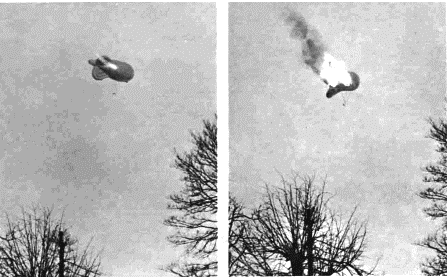Harrow
District Council versus The Air Ministry and No.3 Balloon Centre
It
is interesting to read the responses by various public bodies to the risk of war
and the actions taken by the government to defend this country. In July 1938 the
war clouds were gathering over Europe once again and the government along with
the Air Ministry was keen to ensure that if it came to war Britain would have an
air defence in place. It had been agreed that across the country regional sites
would be developed to house balloon barrage depots.
Harrow
District Council almost had an apoplectic fit when the decision to build a
Balloon Barrage Depot at Stanmore Park was made. Stanmore Park was built Andrew
Drummond, founder of Drummondís Bank and the old family house built in 1750
had been demolished by the Air Ministry. The decision was one that had been made
by the Secretary of State for Air. The Town Planning Committee recommended that
the Secretary of State for Air be informed that the Council viewed with regret
the entire lack consultation with the Council both before the acquisition and in
connection with the lay-out and development of Stanmore Park as balloon barrage
station and depot and deplored the demolition of buildings and felling of trees
on the site. The Council asked that they should be consulted as to the type and
design of buildings which it was proposed to erect on the land. The Council also
included their local M.P. in the correspondence.
Stanmore
Park had been acquired the Crown for use by the Air Ministry as station and
depot for balloon barrage in connection with the defence North London against
hostile aircraft. The land
comprised about 56 acres and had until recently been used as a school and
had woodland. The property was awaiting residential development of eight houses
per acre. Committee observed these facts with considerable regret, for what was
once a spot of natural beauty had now been irreparably spoiled. The Council,
however had no power to prevent the development. They felt it was lack of
courtesy by the government not to have asked their view. Only one councillor
explained that the country was facing a national emergency and he felt the other
members of the council were being unpatriotic. Various members explained that
there were some very valuable houses adjacent to Stanmore Park and the building
of a barrage balloon depot would devalue these.
My
research reveals that in 1938 many councils across the country were objecting to
the actions of the Air Ministry when a balloon barrage depot was being built.
The situation was that even if the council objected then the Air Ministry could
use compulsory purchase in any case. I have concluded that most councils that
objected were unaccepting of the threat of war coupled with their affront at not
having power over the decision. Thank goodness the depots were built despite the
objections from the councils. If they had delayed the building of the depots the
air defence over the country might have been much later in implementation with
disastrous consequences.
The
Stanmore site went on to serve Squadron Nos. 906 at Hampstead, 907 at Woodberry
Down, and 956 at Colnbrook. The first balloon flew over Stanmore on 13th
November 1939. On 26th February 1939 a public demonstration was held
at Stanmore to show the public the air defence provide by a barrage balloon. It
went well until a bolt of lightning struck the balloon and cable causing it to
burst into flames. The crowd watched in horror as the balloon descended in
flames and landed on the roof of one of the hangars containing gas trailers and
other winch vehicles. Quick thinking by the winch driver wound in the flying
cable and dragged the burning balloon of the roof and onto the ground where a
fire engine was able to douse
the fire. Nobody was hurt but it was not a good start for the Centre.

Since
the public did not have a lot of information about the mechanism of balloon
defence this exercise caused many people to think that the balloons were
designed to explode when an enemy aircraft came near. The authorities did not go
out of their way to explain exactly how a balloon was designed to deter
enemy aircraft. The Stanmore Balloon Centre realised that Stanmore Common was
ideal for carrying out balloon exercises and in March 1939 applied to Harrow
Council for permission to use the common, the council refused and referred all
other requests to the Open Spaces Committee.
The men who joined the balloon squadrons came under the Reserve and
Auxiliary Forces Act and were required to be released from work for a month of
training at 3s-9d a day. In June 1939 Deployment of the balloon barrage had
begun and one in four of the men in the Stanmore squadrons were called up for
the one month of training. It was planned that the rest would be called up over
the next three months and this would enable the squadrons to be brought up to
full strength of officers and men. As the last batch were being called up for
September war was declared causing a number of men to be only partly trained. At
that time a balloon cost around £500 and the winch around £1000. The Balloon
Command strength in June 1939 was only 20,000 but with war declared those
numbers began to swell.
Peter Garwood 2021